
Daniel Murphy
-
Posts
1,570 -
Joined
-
Last visited
Content Type
Profiles
Forums
Blogs
Gallery
Events
Store
Posts posted by Daniel Murphy
-
-
There is a definite move in that direction, but for a faker to do this successfully, would require the right stamp on the right type of cross. Each original maker has his own characteristics. It would have to have a known core for that maker and the same beading, hinge, pin, catch and the correct type of mark in the right place. We all know that certain cores, beading, hinges, pins etc, are attributable to certain makers. A "G" or "Godet Berlin" stamp on the pin of a EK1 that does not have the Godet hinge will be spotted as a fake right off. Some other maker marks whose crosses are less well known, would probably not be suspected. However, this cross also is not perhaps a desirable one and may not sell. The fakers go for the rare pieces so they can make the most money quickly. So the wrong stamp on the wrong cross may fool a few people for a little while, but not for any length of time. All they will do is destroy the value of a number of unmarked EK1s and make some money in the short term.
Dan
0 -
Micha,
I think you are a little too picky.
 I don't see a single thing about that one that needs to be upgraded.
I don't see a single thing about that one that needs to be upgraded.  It is quite beautiful as is.
It is quite beautiful as is. Dan
0 -
Chris,
That is a beauty!!

 Wow. I just love the early ones, I would love to get a shot at one of those someday. Even if it was just a demill. Think of where it has been
Wow. I just love the early ones, I would love to get a shot at one of those someday. Even if it was just a demill. Think of where it has been  and what it has done
and what it has done  . My gun was made in mid 1918 and it has the D barrel in it. Each gun was issued with 4 barrels stamped with the serial number and an added A,B,C or D. Each barrel was good for over 10,000 rounds. So even my late gun has fired over 30,000 rounds in anger(and worn out three barrels) during it's short service life in WW1. I would hate to think of the hundreds of thousands of rounds that have passed through that one. I am glad to see the original finish on it has not been messed with, a weapon like this should show its heavy use. The sled is early as well (maybe 1915 or earlier), the brass plate on yours is zinc on my 1917 dated one. Did the water jacket come painted that color?
. My gun was made in mid 1918 and it has the D barrel in it. Each gun was issued with 4 barrels stamped with the serial number and an added A,B,C or D. Each barrel was good for over 10,000 rounds. So even my late gun has fired over 30,000 rounds in anger(and worn out three barrels) during it's short service life in WW1. I would hate to think of the hundreds of thousands of rounds that have passed through that one. I am glad to see the original finish on it has not been messed with, a weapon like this should show its heavy use. The sled is early as well (maybe 1915 or earlier), the brass plate on yours is zinc on my 1917 dated one. Did the water jacket come painted that color?  Never mind that, you really got a great piece. I am green with envy.
Never mind that, you really got a great piece. I am green with envy. 
Dan
0 -
Chris,
It is a common enlisted mans feldmuetze with an added visor and chinstrap. It is an affection of a few enlisted men who were envious of the NCOs visor caps. Totally unauthorized of course, especially since it involved modifications to an issue piece of headgear. I believe this is the first I have seen with a chinstrap though
 .
.Dan
0 -
Here is a link to a little info. Sorry, there was no photo.
 0
0 -
Finally the best clue (since I do not have a first name). The number below his name appears to be a service number "325/3731".
 I would greatly appreciate any help. Thank you.
I would greatly appreciate any help. Thank you.Dan
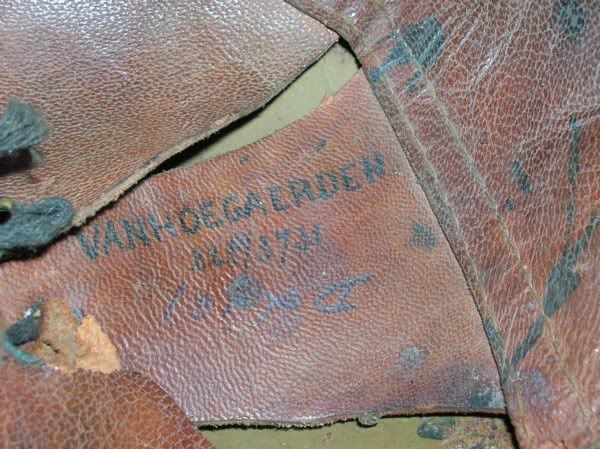 0
0 -
Here his notes his rank as well.
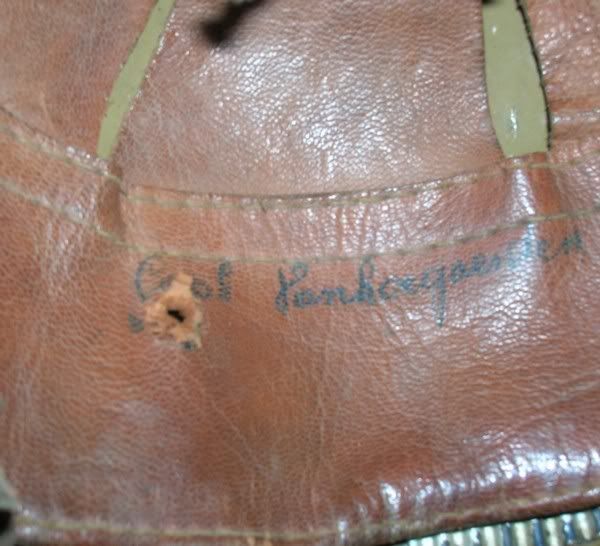 0
0 -
Here his last name is written on the inside of the helmet.
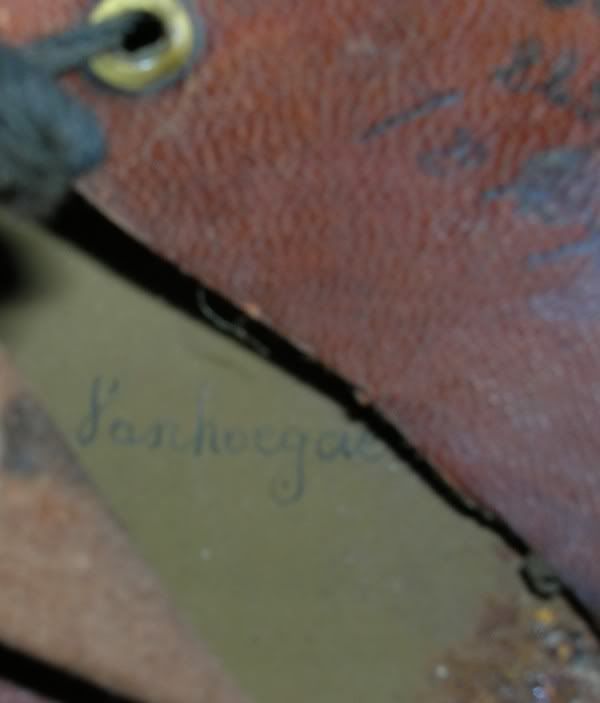 0
0 -
I have had this bullet-holed WW1 Belgian adrian helmet for some time and have always wondered about whether the owner made it home or not. It was definitely not on his head at the time as the liner is in very good condition. The helmet is well marked to the original owner as subsequent photos will show. Unfortunately someone robbed the lion frontplate off it before I acquired it
 Could one or more of our Belgian members help me find out about this officer?
Could one or more of our Belgian members help me find out about this officer?Dan
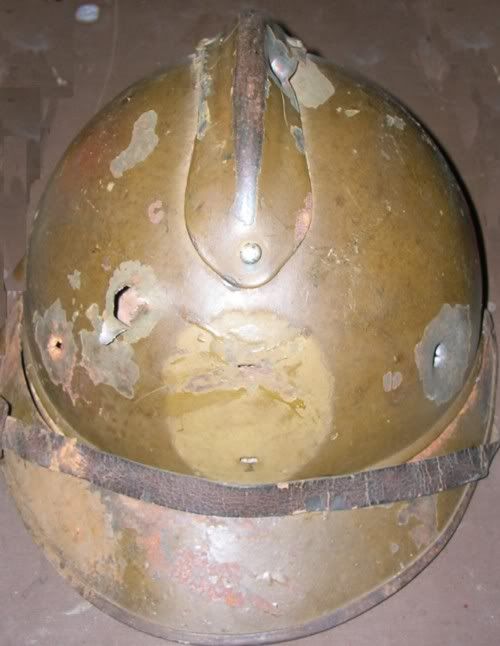 0
0 -
Amazing. I am glad that they though of the historical value of those guns and preserved them. Thanks for the great photos. I have never thought of visiting Norway, but now I may have to plan a visit on my next trip to Europe.

Dan
0 -
I think I'll give up looking for a stick/can that fits the thread.
I have seen several loose sticks on the market over the years, but they were all for the 1917 pattern grenade. I doubt one would fit this early head. The other possibility is to have someone craft you a handle on a lathe from the dimensions of one of your other handles. If you know a local woodworker, they may be able to help you out from a scrap of leftover wood. Complete relic screw cap assemblies are found quite often and you may be able to get one for a handle very reasonably.
Dan
0 -
Gentlemen,
I just found these eagles that I had purchased some time back. I no longer actively collect TR and am not really up to snuff on it anymore. I think they are real, but the fakes have gotten so good I would appreciate your opinions on whether these are good or not. On top is the reverse, on bottom the obverse. Thanks,
Dan
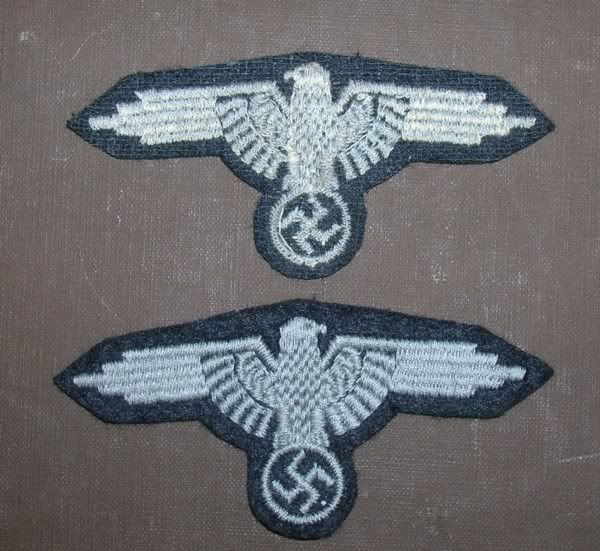 0
0 -
Jaegermeister?
 That stuff is supposed to be an after dinner digestive aid. You are not supposed to drink massive quantities of it.
That stuff is supposed to be an after dinner digestive aid. You are not supposed to drink massive quantities of it.  Seen it done, but it ain't pretty.
Seen it done, but it ain't pretty. Rick,
Nice enamel variation. It looks like an early one with gold medallions. I thought you were pulling a "Sal" on us at first but the color shift did not apply to the ribbon, etc.
Dan
0 -
Tony,
I will do my best.
1. Manufacturers variances. Riveted vs. spot welding. A different way of getting the same job done and not a different model.
2. The can at the bottom and right are first pattern 1915 style. The other one is a later 1915/1916 type. On the first pattern the cans were welded and they experienced a number of failures to detonate. The second type has two prongs than can be bent up and the top removed so that if the grenade is recovered, another exposive charge and fuse can be inserted and the grenade reused.
3. Since the grenades were shipped with the handles already inserted, there was no real need for them to be interchangable. It was a disposable one use item anyway.
4. MOA and HNB were the makers initials. The handle machining variations are not unusual and made no difference to the functioning of the piece, so no big deal as far as the army was concerned. They only cared that it worked.
5. Manufacturer variations again.
6. See #2. above
7. I have six different ones and even I never examined them that close.
 Are there any explanations to this? We all know how Germans love making rules and regulations (no offence meant to any German Beamte reading this).
Are there any explanations to this? We all know how Germans love making rules and regulations (no offence meant to any German Beamte reading this).Modifications? Different makers? Different years of manufacture? Is this too technical and something I shouldn?t really worry about?
Yes. All of the above.

Dan
0 -
Claudio,
Godspeed and good luck on your quest.

Dan
0 -
I agree it is a modified 1914. The original early 1813's had oakleaves that looked more like cabbage leaves and that zig zag stem is a dead givaway. Most real ones have a thin staight stem on the leaves.
Dan
0 -
Nice one Ralph,
Shades of Salvador Dali there.
 So, can we see a before and after shot to make sure it works?
So, can we see a before and after shot to make sure it works?  I would say this came out c. 1913-1915 (centenary of the Freedom Wars) and probably did not last long. They were after all in Chicago which had a heavy German-American population.
I would say this came out c. 1913-1915 (centenary of the Freedom Wars) and probably did not last long. They were after all in Chicago which had a heavy German-American population.Dan
0 -
I am under the impression that when Prussia went to yellow as Foot Artillery underlay in 1915, so did Bavaria:
Yes but the frugal Germans did many unauthorized things, like changing the number and not the board. On the close up of the board shown above it looks like a single central number has been removed (either a 1 or a 2). Look closely between the 1 and 5, see where the silver threads are disturbed where they meet each other? A close up of both boards would certainly help. Can we get one? Is possible he earned the AO3bX as a Leutnant or Oberleutnant and is listed as such despite a later promotion?
Dan
0 -
Yes, Wester used this mark "W & CO." on many of their swords. Had the sword been made by Weyersburg, it would have undoubtedly had the crowned head trademark. Many of Wester's swords were made for the English market I might add.
Dan
0 -
The sword was made by Isaac Wester & Co of Solingen, Germany. They were in business c. 1820-1890. Hmm CMP.
 What about Corps of Military Police?
What about Corps of Military Police? Dan
0 -
My problem is that I do not have access to any useful data on the Bavarian units or their uniforms. Was there a Bavarian 15th Foot Artillery Regt? I have read where the black piping also represented several other branches like perhaps engineer, telegraph, aviation etc. Was the underlay for arty white on the original 1910 boards? If so then these may be the original boards. One other question. In the US Army we have Arty officers attached to Inf units. Did the Bavarians attach arty officers to infantry regiments?
I have references to artillery units attached to the divisions, but heavy (foot) artillery was attached to the army corps, not to the individual divisions. I have found a reference to a 136th Battailon of Prussian foot artillery so there was definitely a massive increase in the number of heavy guns since mobilization. The Bavarian foot artillery entered the war armed with 10cm howitzers. These guns were good, but then you have the wartime production of huge quantities of 15cm, 21cm, 38cm and to a lesser extent, 42 cm guns. All of these guns have to be crewed which led to many new heavy artillery formations being created. I do not doubt that there was at least a Bavarian 15th Foot Artillery Battalion (or parhaps even regiment). It was just a natural progression of the war.
As far as the black piped Brandenburg cuffs on your waffenrock, Only one type of formation used them, Foot Artillery (both Prussian and Bavarian). Other technical units used black piping on the cuffs, but they all had Swedish cuffs with one horizontal row of piping and two buttons side by side. Your Waffenrock is Foot Artillery, it cannot be anything else. According to the 1910 regs all Foot Artillery units (again both Prussian and Bavarian) had white underlay (officers) or white piping (enlisted). I do believe these boards are original to the uniform, they are well sewn in and do not appear to be messed with.
In a great many respects the Imperial German Army differed from the way we (as Americans or English) think it did. We are familiar with our forces so it is common to think everyone did things the same. In the US Army, each Division had artillery whose job was to support THAT division. In the German Army each division had some light artillery, but command and control of all artillery often came from higher up. So that the artillery of one division could be supporting an attack of another division down the line. This is how the massive bombardments were done. If that (1st )division then was raided by the enemy, they may not be able to count on their artillery support. Their artillery could already be busy with another fire mission on orders of the Army Corps or Army. Of course there would be liason officers with the divisional (perhaps even regimental) staff, but they would wear Artillery uniform since they are only attached temporarily. At this time the balloon observers replaced the need for forward observers as we know them now. I hope this helps.
Dan
I have found references to a 10th and a 13th Bavarian Foot Artillery regiments circa 1916. So a 15th Regiment is not out of the question.
DKM
0 -
Oh no. Not another one.



 Here is a link to "Yellow 16" that was just recovered Two Weeks ago from the waters of Norway.
Here is a link to "Yellow 16" that was just recovered Two Weeks ago from the waters of Norway. 
http://forum.12oclockhigh.net/showthread.php?t=6548
And a photo of course.
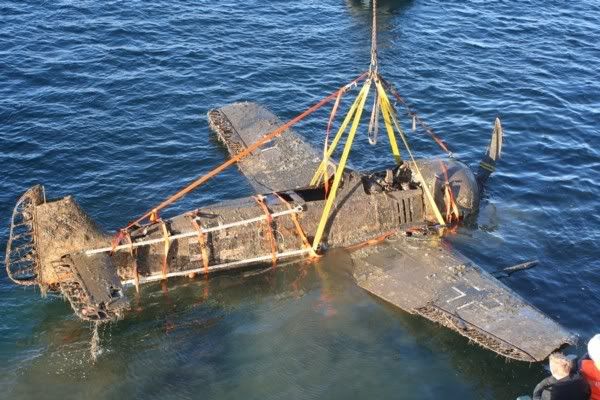 0
0 -
Apparently there is alot of controversy about the restoration of this plane, with one group wanting it left in "as is" condition, while the other group supports the complete restoration which has been ongoing with this aircraft.
From a historical standpoint, restoration is the way to go. Otherwise it will just sit and decay until some later restorer has that much more work to do when it finally is restored. Whether it will be restored to flying condition and flown again depends on how bad it all is when they get it apart. I say restore it to flying condition, take a spin and then park it in a museum. I just hope they keep the same paint sceme and markings. If you find out any more about the plane, I would enjoy hearing about it.
Dan
Nevermind. Here is the link.
0 -
What a find!! O' to be the one that came across that one!
I take it that Russians aren't big hikers?
John,
No kidding! At least it would appear to be soon in German hands for a full restoration. I would say that the Russians are to some extent immune to exitement we feel when something like this is found. This kind of "junk" has littered the fields and forests of eastern Russia since the war. More than likely the locals find it, say "what's here that I can use?", take what they want and leave the rest. Then some foreigner comes along asking about this type of thing and the locals tell him "there's a tank in that river" or "there's a plane in the woods over there". The really hard part is then arranging with the government to be able to recover it, getting the permits to export it and the actual recovery operation. In a situation like this, God only knows how far back in the forest / swamp the plane is and the recovery will be extremely difficult. Definitely possible though. Thankfully no one stripped the insignia off it......yet.
Dan
0


Imperial bars...
in Germany: Imperial: The Orders, Decorations and Medals of The Imperial German States
Posted
I prefer a bar with purely WW1 awards on it. It can have a postwar veterans gong or two, but preferably no Honour Cross. Have I bought them? Yes, and then usually sold it later. But definitely, Never, will I like that d@mned faithful service cross with the swastika. I can tolerate an honour cross, but that thing just ruins the whole bar for me.